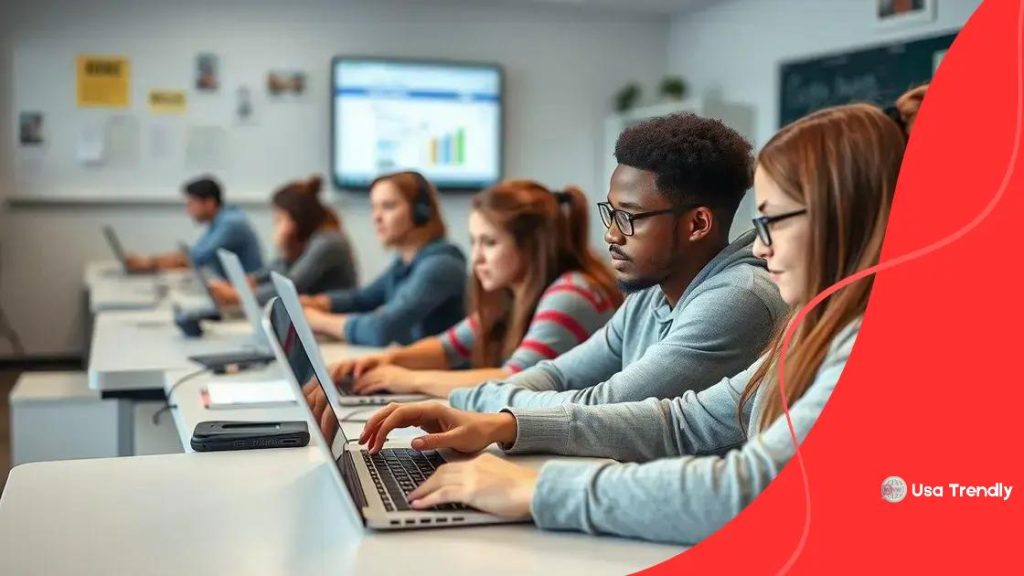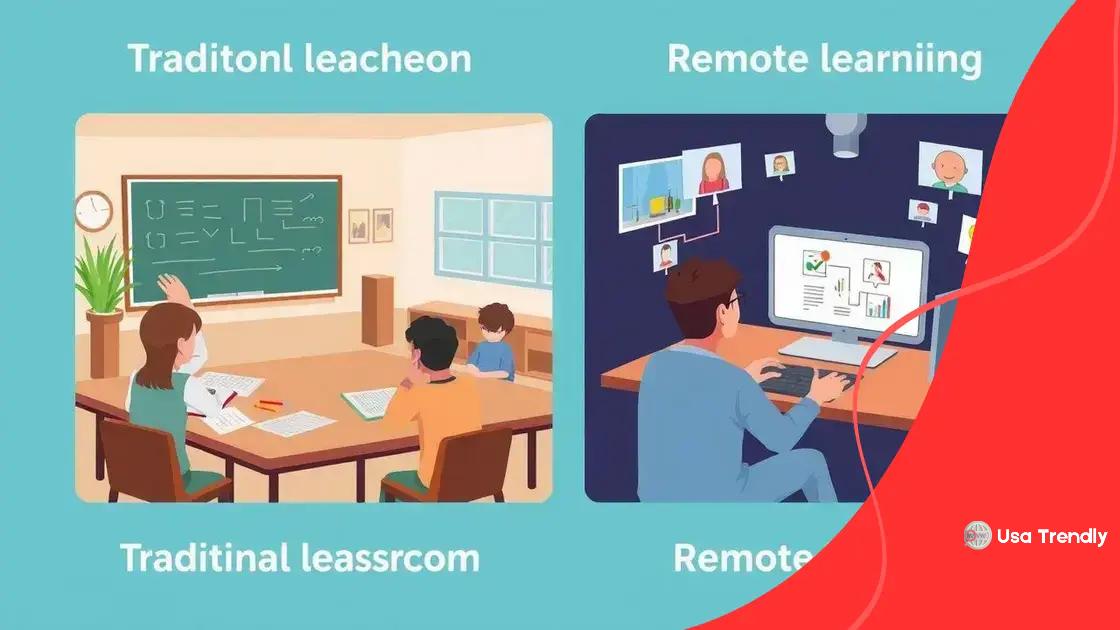Remote learning effectiveness evaluated: What’s the impact?

Remote learning effectiveness evaluated reveals that proper communication, technology use, and structured schedules are essential for enhancing student engagement and achieving successful educational outcomes.
Remote learning effectiveness evaluated reveals insights into how this mode of education can reshape learning experiences. Curious about its true impact on students? Let’s dive into the details!
Understanding remote learning
Understanding remote learning is crucial in today’s educational landscape. As education increasingly shifts online, it becomes vital to explore how this method works and its overall effectiveness.
Remote learning leverages technology to connect educators with students, allowing for flexible learning environments. This approach can help learners access resources and educational materials from anywhere. However, understanding its nuances is essential for maximizing benefits.
Key Components of Remote Learning
Successful remote learning doesn’t just rely on technology; it includes several critical elements that contribute to a productive learning experience. Some of these components are:
- Technology Access: Students need reliable internet and devices to participate.
- Engagement Strategies: Educators must find ways to keep learners motivated.
- Communication Tools: Effective channels for interaction between students and instructors are essential.
- Curriculum Design: Courses should be tailored for online delivery to enhance learning outcomes.
Moreover, fostering a sense of community in remote learning is essential. When students feel connected, they are more likely to engage actively. This can be achieved through virtual group projects, discussion forums, and social media interactions.
Challenges in Remote Learning
Despite its benefits, remote learning presents unique challenges. Students may struggle with distractions in their learning environments, leading to decreased focus. Additionally, the lack of face-to-face interaction can make it difficult for some learners to grasp complex concepts.
Educators are encouraged to adapt their teaching strategies to address these issues. This might include incorporating more interactive components, such as live Q&A sessions and peer reviews, to enhance understanding.
In summary, understanding the multifaceted nature of remote learning is critical. Balancing technology, engagement, and community fosters a productive learning environment. It’s not just about moving classes online; it’s about creating effective and meaningful educational experiences.
Key factors influencing effectiveness
Key factors influencing effectiveness in remote learning are crucial to understand. Several elements can impact how well students learn in this environment, shaping their overall educational experience.
One important factor is the quality of technology used. If students have access to reliable devices and high-speed internet, their learning is likely to be more effective. Without these tools, students may struggle to engage with the material.
Engagement Techniques
Another key factor includes the engagement techniques used by educators. Teachers should incorporate various methods to keep students interested. Some effective strategies include:
- Interactive Lessons: Using quizzes and discussions can enhance participation.
- Group Projects: Collaborating with peers fosters teamwork and deeper understanding.
- Regular Feedback: Providing timely and constructive feedback helps students stay on track.
- Flexible Learning Paths: Allowing students to learn at their own pace can boost their confidence.
Additionally, strong communication between teachers and students plays a vital role. When students feel comfortable asking questions and seeking help, they are more likely to succeed.
Support Systems
Moreover, having a robust support system is essential for remote learners. This can include access to academic resources, counseling, and peer support networks. Students who feel supported are more likely to engage deeply with their studies.
Furthermore, it’s crucial to create a structured routine. Establishing a consistent schedule helps students develop discipline. Integrating breaks into this routine can also prevent burnout and maintain focus, essential for long-term success in remote learning.
All these key factors interact to determine how effectively remote learning works for different students. A balanced approach that considers technology, engagement, communication, support, and structure can significantly enhance the educational experience.
Comparative studies on traditional vs. remote learning

Comparative studies on traditional vs. remote learning reveal important insights into the effectiveness of each educational approach. Understanding these differences helps educators make informed decisions about teaching methods.
Research shows that traditional learning typically involves face-to-face interactions in classrooms. This environment can foster social skills and immediate feedback. In contrast, remote learning allows students to access materials anytime, providing flexibility in their schedule.
Academic Performance
Studies have indicated differing academic performances between the two methods. In general, students in traditional settings tend to perform well due to structured environments. However, remote learning has shown promising results in certain subjects, particularly in tech-related fields.
- Engagement Levels: Studies find that many students engage more actively in remote learning through interactive platforms.
- Self-Discipline: Remote learning often requires a higher level of self-discipline, which can lead to improved time management skills.
- Peer Collaboration: Traditional classrooms promote collaboration, but online platforms also create opportunities for group work.
- Access to Resources: Remote learners can tap into a diverse range of online resources, which enhances their learning experience.
Moreover, studies suggest that student outcomes vary based on individual preferences. Some students excel in traditional environments, while others thrive in remote settings that allow for personalized learning paths. The effectiveness of each approach can depend significantly on how well teachers adapt their methods to meet student needs.
Social Interaction
Social interaction is another significant factor when comparing these two educational formats. Traditional classrooms provide immediate social engagement, allowing students to develop strong relationships with peers and teachers. However, remote learning can also foster social interactions through virtual discussions, forums, and group projects.
Ultimately, the effectiveness of traditional versus remote learning is not cut-and-dry. The best educational experiences often come from combining both methods, using the strengths of each to create a more engaging learning environment.
Challenges faced in remote learning environments
Challenges faced in remote learning environments can significantly impact student success. Understanding these challenges enables educators and institutions to develop strategies that enhance the learning experience.
One major issue is the lack of engagement. Students may feel isolated and disconnected when learning from home. This could lead to decreased motivation and focus, making it harder for them to absorb information effectively.
Technical Difficulties
Another common challenge involves technical difficulties. Not all students have access to reliable internet or devices needed for online classes. This can result in interruptions and hinder their ability to participate fully in lessons.
- Connectivity Issues: Poor internet connections can cause disruptions during important lectures.
- Device Availability: Some students may lack access to computers or tablets necessary for remote learning.
- Technology Skills: Not all students are equally proficient in using digital tools, which can create barriers to learning.
- Software Problems: Glitches and bugs in learning platforms can prevent information from being conveyed smoothly.
Additionally, students may experience challenges in managing their time effectively. Without a structured environment, they might struggle to meet deadlines and balance coursework with personal responsibilities. This can lead to increased stress.
Support and Resources
The absence of immediate support is another hurdle. In traditional settings, students can easily ask questions and get help from teachers or peers. In remote learning, this support may not be as accessible, leaving students feeling unsupported.
Moreover, adapting to a new learning format requires a significant adjustment period. Students are used to the physical classroom environment, and shifting to interactive online classes can take time. This transition might come with feelings of anxiety or confusion as they navigate new tools and platforms.
Recognizing and addressing these challenges is key to improving remote learning outcomes. Schools can implement training programs for both teachers and students to enhance their comfort and proficiency with technology. Providing additional support resources, such as tutoring or counseling, can also help students overcome barriers they face in this learning environment.
Best practices for successful remote education
Best practices for successful remote education can enhance learning experiences for students and educators alike. Implementing effective strategies is essential to ensure that remote learning is engaging and productive.
One key practice is establishing a clear communication strategy. Teachers should set up regular check-ins with students through video calls or messaging apps. This consistent communication fosters a sense of community and encourages students to stay connected.
Set Clear Expectations
Another important aspect is to set clear expectations for both students and teachers. This includes outlining goals, participation requirements, and deadlines. When students know what is required of them, they are more likely to stay organized and focused.
- Use a Structured Schedule: A consistent daily or weekly schedule helps students manage their time effectively.
- Interactive Learning: Incorporating interactive elements such as quizzes, discussion boards, and group projects keeps students engaged.
- Provide Resources: Share supplemental learning materials, such as videos and articles, to enrich their education.
- Encourage Feedback: Creating a feedback loop allows students to express their needs and challenges.
Additionally, fostering a supportive learning environment is critical. Teachers should be approachable, offering encouragement and assistance whenever needed. This support can come in various forms, such as one-on-one tutoring sessions or office hours.
Utilize Technology Effectively
To maximize the benefits of remote learning, it’s important to use technology effectively. Teachers should employ various digital tools and platforms to enhance the learning experience. Tools like virtual whiteboards and collaborative software can facilitate group work and brainstorming sessions.
Moreover, incorporating multimedia assets, like videos and podcasts, can make lessons more engaging and cater to different learning styles. Adapting content delivery methods ensures that all students can benefit from remote education.
Ultimately, by following these best practices, educators can create a robust remote learning environment. Keeping communication open, setting clear expectations, and effectively using technology can lead to successful educational outcomes.
FAQ – Frequently Asked Questions about Remote Learning Effectiveness
What are the main challenges of remote learning?
The main challenges include lack of engagement, technical difficulties, time management issues, and limited support.
How can teachers improve communication with students in remote learning?
Teachers can establish regular check-ins, use messaging apps, and create interactive forums to keep students connected.
What are some effective strategies for remote education?
Effective strategies include setting clear expectations, using technology effectively, and providing supportive learning environments.
How does remote learning compare to traditional classroom learning?
Remote learning offers flexibility and resource access, while traditional learning promotes social interaction and immediate feedback.
SEE MORE CONTENT